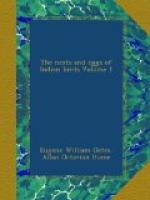The eggs apparently vary extraordinarily in size; they are generally more or less elongated ovals, some slightly pyriform and slightly obtuse at both ends, some rather pointed towards the small end. The shell in all is very fine and compact and smooth, but some have scarcely any appreciable gloss, while others have a really fine gloss. The ground-colour is pretty uniform in all, a delicate pale greenish blue. The markings are always chiefly confined to one end, usually the broad end; even about the large end they are never very dense, and elsewhere they are commonly very sparse or almost or altogether wanting. In some eggs the markings are pretty large irregular blotches mingled with small spots and specks, but in many eggs again the largest spot does not exceed one twelfth of an inch in diameter. In colour these markings are normally a chocolate, often with more or less of a brown tinge, in some of the small spots so thickly laid on as to be almost black, in many of the larger blotches becoming only a pale reddish purple, or here and there a pale purplish grey. In some eggs all the markings are pale and washed out, in others all are sharply defined and intense in colour. Occasionally some of the smaller spots become almost a yellowish brown.
526. Eulabes ptilogenys (Blyth). The Ceylon Grackle.
Eulabes ptilogenys (Bl.), Hume, cat. no. 693 bis.
Colonel Legge writes in his ’Birds of Ceylon’:—“This species breeds in June, July, and August, laying its eggs in a hole of a tree, or in one which has been previously excavated by the Yellow-fronted Barbet or Red Woodpecker. It often nests in the sugar- or kitool-palm, and in one of these trees in the Peak forest I took its eggs in the month of August. There was an absence of all nest or lining at the bottom of the hole, the eggs, which were two in number, being deposited on the bare wood. The female was sitting at the time, and was being brought fruit and berries by the male bird. While the eggs were being taken the birds flew round repeatedly, and settled on an adjacent tree, keeping up a loud whistling. The eggs are obtuse-ended ovals, of a pale greenish-blue ground-colour (one being much paler than the other), sparingly spotted with large and small spots of lilac-grey, and blotched over this with a few neutral-brown and sepia blots. They measure from 1.3 to 1.32 inch in length by 0.96 to 0.99 in breadth.”
527. Calornis chalybeius (Horsf.). The Glossy Calornis.
Calornis chalybaeus[A] (Horsf.), Hume, cat. no. 690 bis.
[Footnote A: Mr. Hume considers the Andaman Calornis distinct from the Calornis inhabiting Cachar, Tenasserim, &c. I have united them in the ’Birds of India.’—Ed.]
Of the Glossy Calornis Mr. Davison remarks that “it is a permanent resident at the Nicobars, breeding in holes in trees and in the decayed stumps of old cocoanut-palms, apparently from December to March. At the Andamans it is much less numerous, and is only met with in pairs or in small parties, frequenting the same situations as it does in the Nicobars.”




